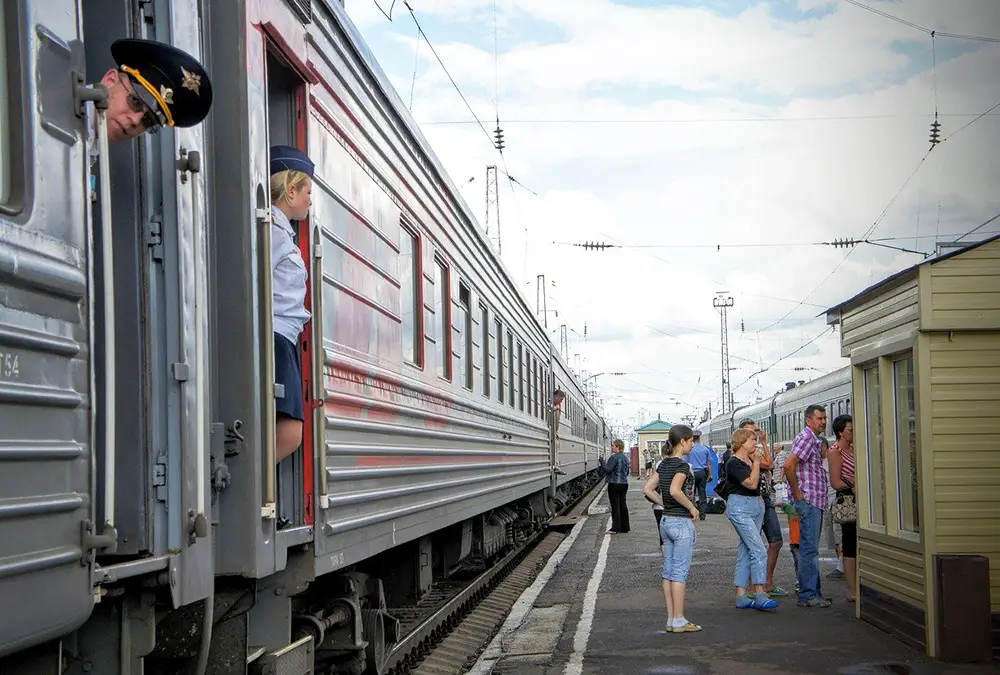The Trans-Siberian Railway is one of the most famous and most awe-inspiring railways in the world. Traveling on it is a dream for so many people with a taste for adventure.
Here are 25 amazing facts about this railway to help show you just how truly incredible it really is:
#1 – This railway is the longest continuous journey you can take via rail: it is over 9,200km long. That is twice the length of the Continental United States which is 4300km wide. If you imagine one continuous rail line from the east to the west coast that then turns back on itself and runs parallel from the west back to where you started at the east coast then you would still be shorter than the Trans-Siberian railway.
#2 – The railway stretches the entire length of Russia so if you are looking for the best way to see as much of Russia as possible this is certainly the best way for you. No other forms of transportation offer such a unique and interesting view of the Russian landscape. The railway line runs through places you would never otherwise see by road.
#3 – Originally being built in 1906, this railways survived largely the First and Second World Wars and is much the same route as it was when it was first built. You would be taking the same journey famous artists, scientists, and politicians took over 100 years ago.
#4 – A trip along the full length of the track can take just as few as 6 days now, compared to the two weeks it might have when it was first built. It may still sound like a long time to be on a train, and it is, but it is so worth it. You must remember you will probably be asleep for two of those days, so it is important to plan your sleep schedule ahead so you don’t miss anything you may have wanted to see.
#5 – You don’t have to stay on the train for the whole 6 days if that sounds too long! Don’t worry, you can break it up into smaller sections of the track at a time. You must bear in mind though that each section will need its own ticket purchased two months in advance if this is the way you plan to travel, so you must decide beforehand.
#6 – The Trans-Siberian has a second section of track called the Trans-Mongolian Railway which goes from Moscow to Beijing instead. This journey also takes another 6 days each way so if you plan to do both it could take a while. If you plan to travel both railways exclusively it will take you 24 days of rail travel and about 3-4 thousand US dollars.
Here’s a video tour of the trains’ first class:
Video Credit: Naick and Kim – Click Here to watch directly on YouTube
#7 – It does not have to be super expensive, you can travel via 1st, 2nd or 3rd class. If lack of more privacy doesn’t bother you, the third class is an open bunk setup, which can make the whole journey so much cheaper. Many people aren’t a fan of this though, which is fair. The second class is very reasonably priced for what you will be experiencing and is a popular choice for many tourists.
#8 – A common misconception is that this isn’t a safe way to travel. It is completely safe, the trains are full of families and other tourists they are incredibly culturally diverse. Take the normal precautions you would anywhere else, lock your room, keep your valuables hidden just in case and if you just use your common sense you and your property will be perfectly fine.
#9 – The process of building the Trans-Siberian was ordered by Tsar Alexander III in 1891. (Find out more about Russia under the Three Tsars.) Most of the building took place between 1892-1896 but the line wasn’t finished until 1906. It took 15 years to build the majority of the track and it has had ongoing maintenance and upgrades when needed ever since.
#10 – The railways were first built because Siberia had no real contact with the rest of the country. It was far too cold and far too long of a journey by a horse 100 years ago, so Siberia ended up being incredibly isolated before this railway. Since the railway, however, Siberia has become more included in the rest of the countries’ happenings all year round.
#11 – This railway played a major role in World War 2 for Russia. The rivers of Russia would freeze during winter and shipping food, ammunitions and soldiers would become impossible by water. The railway was able to function throughout the coldest months and allowed the Russian war machine to keep working.
#12 – Almost the entire railway survived World War 2, with Germany opting not to try to bomb it so they could use it when they conquered Russia. Which obviously never happened. This means that many of the sections of the rail in use today were in use during both World Wars! Riding on 100-year-old rail may sound scary but it is incredibly well made and maintained.
#13 – The Trans-Siberian railway actually only operates two trains at any one time which the main reason why tickets are so expensive and you need to book so far ahead. This railway is not made up of dozens of tracks like so many others around the world, it is a much more closed circuit.
Image by Peggy und Marco Lachmann-Anke from Pixabay
#14 – There are 120 stations on the mainline stopping in over 90 cities. This is a large reason why the journey can take so long, as the train ends up stopping every 1.5 hours. If you were planning on getting off at every stop to have a look around and stretch your legs, feel free to do so! But you will probably end up sleeping through a majority of the stops as they happen at night.
#15 – This railway is in fact so long that you will pass through a total of eight time zones. If you are keeping time using a watch rather than automatically updating the clock on your smartphone, good luck. It may not even be worth it to have a watch but if you do choose to use one, make sure you update it whenever necessary because the trains run on the local time.
#16 – Each carriage has two western-style toilets, so if you aren’t a fan of sharing a public washroom with strangers for 6 days this may not be the best trip for you. Even those in first-class have to share! Washrooms are just too big to warrant having private ones for each person’s compartment so they have opted to have more space per compartment and shared bathrooms instead.
#17 – There aren’t actually any trains named the “Trans-Siberian Express” as so many people believe. It is commonly mistaken for the Orient Express but they are two very different trains that travel to very different parts of the world.
#18 – The railway starts in Russia and ends up in Vladivostok, although many people expect it to end in Khabarovsk as that is the furthest east the line goes. But it actually doubles back on itself to Vladivostok before terminating (and is the closest Russian train track to Japan).
#19 – The food is actually pretty good now, it hasn’t always been the case especially in the early days but they have really made an effort to improve the quality and selection that will be available to you onboard. You are also able to purchase snacks and drinks from the stops at the various stations on the way.
#20 – The cost of a first-class ticket, one way from Moscow is about US$1.000 including food. If you don’t plan to get off the train, that actually works out as a good price for a weeklong holiday. The second class is about US$650 which is much more affordable but also much more basic rooms and foods are provided.
#21 – The whole train is heated comfortably, even in winter, but that doesn’t stop the temperatures from reaching as low as -40 degrees Celsius (which is coincidentally also the same in Fahrenheit!) when you step outside. If you plan on getting off the train to stretch your legs at the various stations on the way, you will need to make sure you wrap up very warm. Hat, gloves, scarf etc, the whole works. Frostbite can get you very quickly at such low temperatures and that would really spoil your trip.
#22 – The train stops at many of Russia’s most important and impressive cities. You don’t have to get off for very long and have a look around, but it is advised to break up your journey and explore what Russia has to offer. A view from the train is one thing, a view from the city streets is another.
#23 – The Trans-Siberian Railways is actually even longer than the Great Wall of China, if that helps you visualize just how gargantuan this railway line is. Unlike the Great Wall, even with perfect conditions, the railway cannot be seen from space.
#24 – Many people aren’t aware that this journey can be undertaken all year round. It is a lot less busy in the very coldest and darkest winter months and cheaper too because of this, but you do get to see a different side of Russia in all its winter wonderland glory.
#25 – The Trans-Siberian Railways pass through many small tunnels, but the longest is only 2km long. This may seem strange to you as nowadays many trains and cars travel through much longer tunnels, but if you consider that this railway line was built in the 1800s, you realize that the 2km of the tunnel had to be cleared out largely by hand, making it all the more impressive.
The Trans-Siberian Railway truly is one of the most incredible journeys you could undertake in your lifetime. If you manage to get the opportunity to go, I’m sure you won’t regret it. If you are looking for a way to feel like an explorer of old, this is your best bet.
You might also like the following facts about the best railway journeys in the world:




